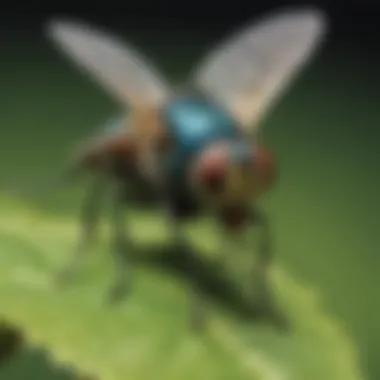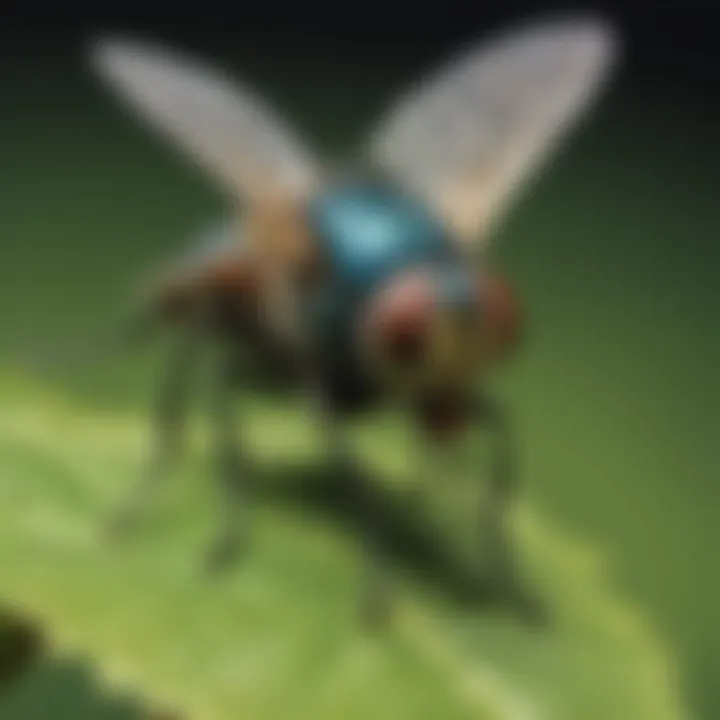Mastering the Art of Attracting Flies: A Comprehensive Guide


Science Fun Facts
Flies are intriguing creatures that play a vital role in ecosystems. Did you know that flies have highly developed compound eyes, allowing them to detect quick movements and changes in light? As for their sense of smell, flies have specialized antennae that help them locate food sources from a distance. Understanding these adaptations can shed light on how to effectively attract flies.
Discover the Wonders of Science
When it comes to attracting flies, science offers valuable insights. By delving into the world of olfactory cues and bait preferences, individuals can fine-tune their fly-attracting strategies. Scientific studies have shown that flies are particularly drawn to odors like ammonia, decaying matter, and sweet substances. By leveraging this knowledge, one can create a targeted approach to attract flies effortlessly.
Science Quiz Time
Are you ready to test your knowledge on fly attraction? Here's a brain teaser for you: What environmental factor is most likely to attract flies to a given area? A) Bright sunlight B) Complete darkness C) Rotting fruit scent D) Cool, dry air. Take a moment to ponder this question before we unveil the answer later in the article.
Science Experiment Showcase
Engage in a hands-on exploration of fly attraction with a fun experiment. Gather materials such as sugar water, vinegar, and a container. Create a fly-attracting solution by mixing these ingredients and observe how flies are drawn to the scent. Document your findings and reflect on the effectiveness of different baits in luring flies. Remember to handle materials safely and maintain a clean environment while conducting this experiment. Stay tuned for step-by-step instructions on how to conduct this engaging science experiment.
Understanding Flies
Understanding the behavior of flies is a critical aspect of any strategy aimed at attracting these insects. Flies, being highly responsive to environmental stimuli, exhibit distinct behavioral patterns that influence their habits and movements significantly. By delving into their daily routines, feeding habits, and flight patterns, individuals can gain valuable insights into how flies interact with their surroundings. This understanding forms the cornerstone of successfully luring flies towards desired areas and activities.
Behavioral Patterns
Daily Routines
One of the key aspects of a fly's behavior is its daily routines. These insects are creatures of habit, following a set pattern in their activities throughout the day. Understanding their daily routines provides essential information for effectively baiting and attracting flies. By knowing when and where flies are most active during specific hours, individuals can strategically place baits and scents to maximize their appeal.
Feeding Habits
Flies have distinct feeding habits that play a crucial role in their attraction to different types of baits. Their preference for sugary substances, decaying matter, or protein-rich foods influences the choice of baits that are most appealing to them. By comprehending the nuances of fly feeding behaviors, individuals can tailor their baiting strategies to target specific fly species effectively.
Flight Patterns
Flight patterns are another vital element of fly behavior to consider when aiming to attract these insects. Flies have unique flight characteristics based on factors such as species and environmental conditions. Understanding their flight patterns helps in positioning baits and scents strategically to intercept flies in their flight path. By capitalizing on their flight behaviors, individuals can lure flies more efficiently towards desired locations.
Environmental Preferences
Habitats
Flies show preferences for specific habitats that offer ideal conditions for their survival and reproduction. Identifying these favored habitats, such as areas with decaying organic matter or sources of moisture, can aid in attracting flies effectively. By understanding their habitat choices, individuals can create environments that mimic these conditions to draw flies towards designated areas.


Temperature
Temperature plays a significant role in the behavior and activity levels of flies. These insects are responsive to temperature variations, with certain temperatures being more conducive to their movement and feeding behaviors. By adjusting environmental temperatures to suit the preferences of target fly species, individuals can enhance the attractiveness of their baiting strategies.
Light Conditions
Light conditions also influence fly behavior, with flies showing varying responses to different lighting levels. Some fly species are attracted to bright light, while others prefer dimmer environments. By manipulating light conditions to align with the preferences of target fly species, individuals can increase the effectiveness of their fly-attracting initiatives.
Choosing Suitable Baits
When it comes to attracting flies, the selection of baits plays a paramount role in the success of the endeavor. The type of bait chosen can significantly influence the effectiveness of the attraction process. One must carefully consider the specific elements, benefits, and considerations related to choosing suitable baits. Different baits have varying levels of attractiveness to flies, hence understanding the preferences of flies is crucial to optimize the bait selection process.
Organic Baits
Organic baits are a crucial component in the process of attracting flies. They mimic natural substances that flies are naturally drawn to, making them an effective choice for bait. Among organic baits, Fruits stand out as a popular choice. Their natural sweetness and aroma make them irresistible to flies. The key characteristic of fruits is their ability to emit a strong scent that flies find enticing. However, one drawback of using fruits as bait is their perishable nature, which might require frequent replacement to maintain their effectiveness in attracting flies.
Another organic bait, Decaying matter, plays a vital role in the attraction of flies. Flies are attracted to decaying organic material as it signifies a potential food source for them. The key characteristic of decaying matter is its strong odor, which acts as a powerful attractant for flies. Despite its effectiveness, one disadvantage of using decaying matter as bait is the unpleasant smell it produces, which may cause discomfort.
Sugary substances also serve as effective organic baits for attracting flies. The sweetness of sugary substances appeals to flies, drawing them towards the bait. The key characteristic of sugary substances is their ability to provide an instant source of energy for flies. However, a disadvantage of using sugary substances is that they can become sticky and difficult to manage, requiring careful handling to avoid messiness.
Protein-Based Baits
In addition to organic baits, protein-based baits are another essential component in attracting flies. Meat is a protein-based bait that has proven to be highly attractive to flies. The strong odor of meat acts as a powerful stimulant, drawing flies from a distance. The key characteristic of meat is its high protein content, which appeals to flies' dietary preferences. However, one challenge of using meat as bait is its potential to attract other unwanted pests besides flies.
Fish products are another protein-based bait that is effective in attracting flies. The pungent smell of fish products is particularly appealing to flies, making them a popular choice for bait. The key characteristic of fish products is their strong odor profile, which can persist for a considerable time, continuously attracting flies. Despite their effectiveness, one disadvantage of using fish products is their tendency to decompose rapidly, necessitating frequent replacement.
Dairy items also serve as valuable protein-based baits for attracting flies. The strong scent and high protein content of dairy items make them alluring to flies seeking nourishment. The key characteristic of dairy items is their perishable nature, which can attract flies quickly upon placement. However, one drawback of using dairy items as bait is the potential for them to spoil rapidly, requiring regular maintenance to ensure their effectiveness.
Utilizing Attractive Scents
In this section, we delve into the crucial aspect of attracting flies through the effective utilization of scents. Utilizing scents is a strategic method to lure flies, leveraging their keen sense of smell. Flies are drawn to specific fragrances, making this an essential component in the process of attraction. By understanding the science behind scents that appeal to flies, individuals can enhance their success in attracting these insects. The selection of scents plays a pivotal role in the overall strategy of fly attraction.
Effective Fragrances
When it comes to effective fragrances for attracting flies, several key categories stand out: garbage scents, ripened fruits, and fermented liquids. Each category has its unique appeal and contributes differently to the goal of attracting flies. Let's explore these categories in detail to grasp their significance in the realm of fly attraction.
Garbage scents
Garbage scents, despite their repulsive nature to humans, are incredibly enticing to flies. The pungent, rotting odors emitted by decaying organic matter act as a powerful magnet for flies. The distinctive characteristic of garbage scents lies in their ability to mimic natural decomposition processes, which inherently attracts flies due to their feeding habits. While unpleasant to us, these scents serve a crucial purpose in attracting flies efficiently.


Ripened fruits
On the other end of the spectrum, ripened fruits offer a sweet and alluring fragrance that appeals to flies. The natural sugars present in ripe fruits release aromatic compounds that act as a potent attractant for flies seeking sources of nutrition. Flies are instinctively drawn to the scent of ripened fruits as it indicates a potential food source, making this category a popular choice for fly attraction strategies.
Fermented liquids
Fermented liquids emit a distinct scent that signals decomposition and fermentation to flies. The fermentation process produces complex odors that flies find irresistible, guiding them towards the source. This category of fragrances taps into flies' innate attraction to decay and fermentation, making fermented liquids a strategic choice for those aiming to attract flies effectively.
Avoiding Repellent Scents
While selecting scents to attract flies, it's equally crucial to steer clear of repellent scents that may deter these insects. Citrus, mint, and herbal scents are examples of fragrances that often repel flies due to their strong and overpowering nature. Understanding the repellent properties of these scents is essential to avoid inadvertently driving flies away, thus optimizing the effectiveness of fly attraction strategies.
Citrus
Citrus scents, characterized by their sharp and zesty notes, are known for their ability to repel flies. The high concentration of citrus compounds creates an aromatic barrier that flies find unpleasant, steering them away from the source. While citrus scents hold positive connotations for humans, they serve as a deterrent for flies, making them unsuitable for attracting these insects.
Mint
Mint scents exude a refreshing and invigorating aura that appeals to humans but repels flies. The menthol present in mint leaves imparts a strong, lingering scent that interferes with flies' olfactory receptors, deterring them from landing or staying in mint-scented areas. Although popular in human products, mint scents are counterproductive in attracting flies.
Herbal scents
Herbal scents, encompassing a wide range of aromatic profiles, often repel flies due to their complex chemical composition. While favored in human aromatherapy and culinary pursuits, certain herbal scents contain compounds that flies find aversive, prompting them to seek alternative environments. Understanding the nuances of herbal scents is vital to avoid hindering fly attraction efforts and maintain a conducive environment for these insects.
Creating Ideal Conditions
In the pursuit of attracting flies, the importance of creating ideal conditions cannot be overstated. Flies are creatures of habit, and their presence is heavily influenced by the environment they inhabit. By meticulously crafting the perfect setting, individuals can significantly enhance their chances of attracting these winged insects. Ideal conditions encompass a variety of factors, including moisture levels, temperature, and humidity. Understanding and optimizing these elements is pivotal in luring flies effectively.
Moisture Levels
Damp areas
Damp areas play a crucial role in creating an environment that is conducive to fly attraction. These locations provide flies with the necessary moisture for survival and reproduction. Damp areas are characterized by their high humidity levels and damp surfaces, which are particularly appealing to flies seeking hydration. Despite the common notion that damp areas are unsightly, they serve as prime spots for attracting flies due to the favorable conditions they offer. The unique feature of damp areas lies in their ability to retain moisture, creating an environment that is irresistible to flies. While dampness can foster fly activity, it is essential to control excess moisture to prevent other pests from being attracted as well.
Standing water
Standing water holds significant allure for flies due to its abundance of moisture and potential breeding grounds it provides. Flies are naturally drawn to standing water as it serves as a vital resource for their survival. The key characteristic of standing water is its ability to act as a thriving ecosystem for fly larvae, facilitating their growth and development. As a beneficial choice for attracting flies, standing water should be strategically positioned to maximize its appeal to these insects. However, it is essential to monitor and manage standing water sources carefully to prevent it from becoming a breeding ground for other pests.
Hydration sources


Hydration sources, such as leaky pipes, dripping faucets, or even pet drinking bowls, are essential components in creating ideal conditions for attracting flies. Flies require access to water for various activities, including breeding and feeding. Hydration sources provide flies with a reliable and accessible water supply, making them indispensable in a fly-attracting strategy. The unique feature of hydration sources is their ability to sustain fly populations in the vicinity, ensuring a steady influx of these insects. While hydration sources are effective in drawing flies, regular inspection and maintenance are crucial to prevent water stagnation and the emergence of potential breeding sites.
Temperature and Humidity
Warm environments
Warm environments play a significant role in attracting flies, as these insects thrive in temperate conditions. Flies are attracted to warm environments due to the abundance of food sources, comfortable breeding conditions, and increased activity levels. The key characteristic of warm environments is their ability to accelerate fly metabolism, leading to heightened reproductive rates and faster development cycles. As a popular choice for attracting flies, warm environments should be optimized to maintain a consistent temperature range that is conducive to fly activity. However, it is essential to regulate warmth levels effectively to avoid creating an environment that is excessively hot and uncomfortable for flies.
High humidity levels
High humidity levels create an ideal setting for attracting flies, as these insects prefer environments with ample moisture content. Flies are especially drawn to areas with high humidity due to the availability of water sources and suitable habitat for breeding. The key characteristic of high humidity levels is their ability to support fly survival by reducing the risk of desiccation and facilitating egg hatching. As a beneficial choice for attracting flies, maintaining high humidity levels can significantly enhance the effectiveness of fly-attracting strategies. Nevertheless, it is crucial to balance humidity levels to prevent excessive dampness, which may attract other pests and compromise the fly-attracting process.
Optimal conditions
Optimal conditions encompass a harmonious combination of factors that are perfectly tailored to attract flies and sustain their presence. Achieving optimal conditions involves striking a delicate balance between moisture levels, temperature, and humidity to create an environment that is irresistible to flies. The key characteristic of optimal conditions is their ability to provide flies with everything they need for survival and reproduction, ensuring a thriving population within the targeted area. As a popular choice for attracting flies, optimal conditions should be meticulously maintained to maximize the efficacy of fly-attracting efforts. While creating optimal conditions is essential for successful fly attraction, continuous monitoring and adjustments are necessary to adapt to changing environmental factors and ensure long-term effectiveness.
Implementing Strategies
In the quest to attract flies effectively, the implementation of strategies plays a pivotal role. Understanding the behavior and preferences of flies is instrumental in this process. By strategically placing baits in locations that cater to the flies' habits and environment, the chances of attracting them increase significantly. Moreover, ongoing maintenance ensures the baits remain appealing and attractive to the flies over time. This section delves into the key aspects of implementing strategies, emphasizing the importance of being proactive and consistent in efforts to lure flies.
Placement of Baits
Strategic locations
In the realm of fly attraction, strategic locations are more than just mere spots to place baits. These locations are carefully selected based on thorough observation of fly behavior and movement patterns. By placing baits in areas where flies frequently gather or traverse, such as near garbage bins or outdoor dining areas, the effectiveness of attracting flies is heightened. Strategic locations capitalize on the flies' natural inclination towards specific environments, increasing the chances of successful bait consumption and trap effectiveness.
Distance from living spaces
When considering the ideal distance to situate baits from living spaces, a delicate balance must be struck. Placing baits too close to human habitation can lead to unwanted fly interaction indoors. Conversely, positioning baits too far might reduce their efficiency in attracting flies. Finding the sweet spot where baits are within the fly's range but not a nuisance to inhabitants is key. This aspect highlights the need to mitigate fly presence without compromising human comfort and health.
Accessibility
The accessibility of baiting locations significantly impacts the overall success in attracting flies. Baits placed in easily accessible spots facilitate efficient monitoring and maintenance. Simultaneously, accessible baits are more likely to catch the attention of flies, leading to higher interaction rates. However, striking a balance between accessibility and safety is crucial to prevent unintended consequences. Ensuring baits are reachable for flies while being secure from interference by pets or children is essential in this aspect of fly attraction.
Regular Maintenance
Refreshing baits
One of the fundamental practices in fly attraction is the regular refreshing of baits. This action involves replacing old, stale baits with fresh ones to maintain their allure to flies. By refreshing baits at appropriate intervals, the attractiveness and effectiveness of the baiting strategy are sustained. This process prevents baits from becoming unappealing or ineffective, ensuring a continuous flow of fly activity towards the targeted areas.
Cleaning feeding areas
A clean feeding area is paramount in the realm of fly attraction. Regular cleaning of feeding areas not only maintains hygiene but also prevents competing odors or substances from deterring flies. Clean feeding spaces enhance the attractiveness of baits, ensuring flies are drawn solely to the baiting station. Additionally, cleanliness reduces the risk of contamination and provides a conducive environment for successful fly trapping.
Monitoring activity
Monitoring fly activity is essential to gauge the effectiveness of the attraction strategies employed. By observing the frequency and duration of fly visits, adjustments can be made to enhance baiting practices further. Monitoring activity allows for the identification of peak fly times, favored bait types, and areas of high fly concentration. This data-driven approach enables a more targeted and efficient fly attraction process, improving overall success rates in capturing flies.







